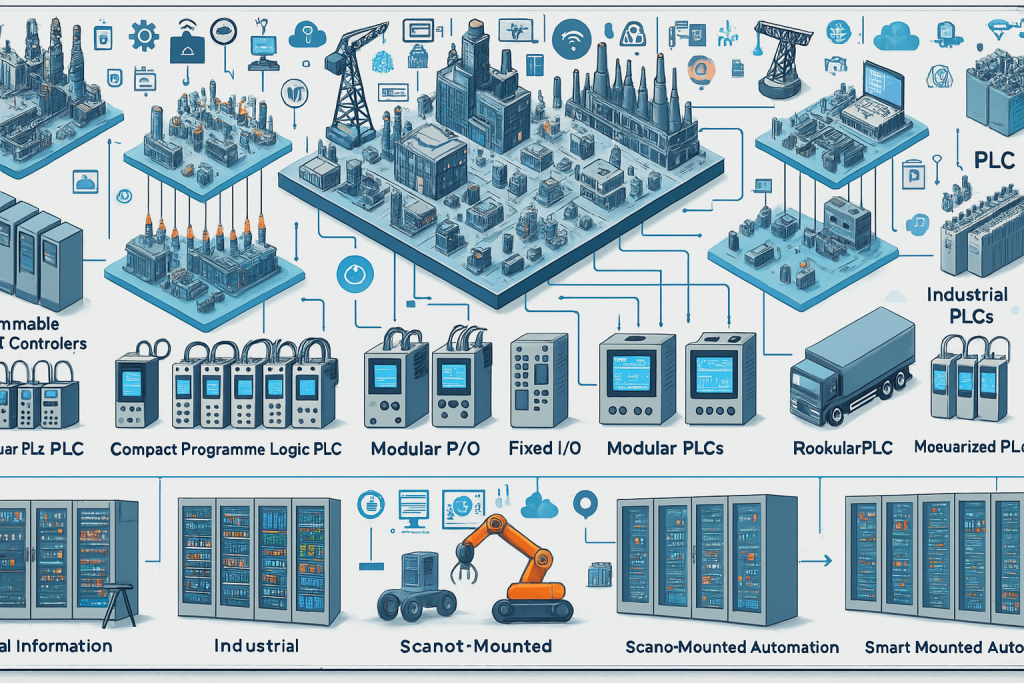Types of PLCs and Their Applications
Programmable Logic Controllers (PLCs) come in different types, each designed to cater to specific industrial needs. The classification of PLCs is based on size, configuration, functionality, and application scope. Choosing the right type of PLC is crucial for efficient automation, cost-effectiveness, and scalability.

This page provides a detailed overview of the different types of PLCs, their key features, and real-world applications.
1. Classification of PLCs
PLCs are broadly classified into three types based on their physical structure and functionality:
- Compact PLCs (Fixed I/O) – Small-scale automation
- Modular PLCs – Medium to large-scale automation
- Rack-mounted PLCs – Large and complex industrial control
2. Compact PLCs (Fixed I/O PLCs)
Compact PLCs, also known as Fixed I/O PLCs, have a predefined number of inputs and outputs (I/Os), which cannot be expanded. They are smaller, cost-effective, and ideal for simple automation tasks.
Key Features
- Pre-configured I/O modules (fixed number of digital and analog inputs/outputs)
- Small-sized and cost-effective
- Simple programming and easy setup
- Limited processing power (compared to modular PLCs)
Best Suited For
- Small automation projects
- Standalone machines
- Home automation systems
- Packaging and labeling machines
Example Application
A small conveyor belt system in a bottling plant uses a compact PLC to control the movement of bottles, ensuring that each bottle stops at the filling station before moving forward.
Best Brands: Siemens S7-1200, Allen-Bradley MicroLogix, Mitsubishi FX Series
3. Modular PLCs
Modular PLCs consist of separate modules for power supply, CPU, I/O interfaces, and communication, allowing for greater flexibility and scalability.
Key Features
- Customizable I/O configuration (expandable input/output modules)
- Supports analog and digital sensors
- Higher memory and processing power
- Connectivity with SCADA and MES systems
Best Suited For
- Medium to large-scale industrial automation
- Manufacturing and assembly lines
- Chemical and pharmaceutical industries
- Energy management systems
Example Application
In a smart factory, a modular PLC controls multiple robotic arms, conveyor belts, and packaging systems, all working together to assemble and pack products efficiently.
Best Brands: Siemens S7-300/S7-1500, Allen-Bradley CompactLogix, Omron CJ2M
4. Rack-Mounted PLCs
Rack-mounted PLCs, also called large PLCs or industrial PLCs, are designed for complex control systems requiring high processing power, extensive I/O, and advanced networking capabilities.
Key Features
- Highly expandable – Supports multiple I/O, CPU, and communication modules
- Handles large-scale automation tasks
- High-speed data processing and real-time monitoring
- Redundancy and failover support for critical applications
Best Suited For
- Oil and gas industries
- Automotive and aerospace manufacturing
- Power plants and utilities
- Water treatment facilities
Example Application
A thermal power plant uses a rack-mounted PLC to monitor and control turbines, generators, cooling systems, and electrical substations while ensuring efficient power distribution.
Best Brands: Siemens S7-400, Allen-Bradley ControlLogix, Schneider Modicon M580
5. Special Types of PLCs
Apart from the standard classifications, there are specialized PLCs designed for unique applications.
A. Safety PLCs
- Ensures worker and machine safety
- Used for emergency stop and fail-safe operations
- Compliance with safety standards (SIL, IEC 61508, ISO 13849)
Examples: Allen-Bradley GuardLogix, Siemens S7 Safety PLCs
B. Motion Control PLCs
- High-speed processing for robotic systems
- Used in CNC machines, robotic arms, and servo motor controls
Examples: B&R Automation PLCs, Siemens Sinamics PLCs
C. Redundant PLCs
- Dual CPU or hot-standby systems for uninterrupted operation
- Used in power plants, refineries, and large-scale automation
Examples: Schneider Electric Quantum, Siemens S7-400H
6. Choosing the Right PLC – Key Considerations
- Application Complexity – Simple, medium, or large-scale automation
- I/O Requirements – Number and type of input/output devices
- Processing Speed – Scan time and real-time response needs
- Scalability – Future expansion and system upgrades
- Communication Protocols – Ethernet/IP, Profibus, Modbus support
- Environmental Factors – Harsh conditions, temperature, humidity resistance
Example Selection Guide
| Application Type | Recommended PLC Type |
|---|---|
| Small machines (standalone) | Compact PLC |
| Manufacturing & process automation | Modular PLC |
| Large-scale industrial automation | Rack-mounted PLC |
| Safety-critical applications | Safety PLC |
| Robotics & motion control | Motion Control PLC |
PLCs come in various types and configurations, each suited to specific industrial needs. Whether it’s a small packaging machine, a smart factory, or a power plant, choosing the right PLC type is crucial for ensuring efficiency, scalability, and reliability.
- Compact PLCs – Ideal for small automation and cost-effective solutions
- Modular PLCs – Best for medium to large-scale industries with expandability
- Rack-mounted PLCs – Designed for large, complex industrial automation
As industries move towards Industry 4.0, PLCs will continue to evolve, integrating IoT, AI, and advanced data analytics for real-time smart automation.

I’m not sure where you’re getting your info,
but great topic. I needs to spend a while learning much more or figuring out more.
Thanks for wonderful info I used to be in search of this information for
my mission.